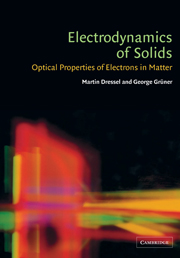14 - Broken symmetry states of metals
Published online by Cambridge University Press: 20 May 2010
Summary
The exploration of the electrodynamic response has played an important role in establishing the fundamental properties of both the superconducting state and the density wave states. The implications of the BCS theory (and related theories for density waves) – the gap in the single-particle excitation spectrum, the phase coherence in the ground state built up of electron–electron (or electron–hole) pairs, and the pairing correlations – have fundamental implications which have been examined by theory and by experiment, the two progressing hand in hand. The ground state couples directly to the electromagnetic fields with the phase of the order parameter being of crucial importance, while single-particle excitations lead to absorption of electromagnetic radiation – both features are thoroughly documented in the various broken symmetry states. Such experiments have also provided important early evidence supporting the BCS theory of superconductivity.
There is, by now, a considerable number of superconductors for which the weak coupling theory or the assumption of the gap having an s-wave symmetry do not apply. In several materials the superconducting state is accounted for by assuming strong electron–phonon coupling, and in this case the spectral characteristics of the coupling can be extracted from experiments. Strong electron–electron interactions also have important consequences on superconductivity, not merely through renormalization effects but also leading possibly to new types of broken symmetry. In another group of materials, such as the so–called high temperature superconductors, the symmetry of the ground state is predominantly d-wave, as established by a variety of studies.
Information
- Type
- Chapter
- Information
- Electrodynamics of SolidsOptical Properties of Electrons in Matter, pp. 371 - 396Publisher: Cambridge University PressPrint publication year: 2002
